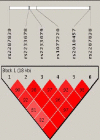Association studies between common variants in prolyl isomerase Pin1 and the risk for late-onset Alzheimer's disease
- PMID: 17482359
- PMCID: PMC1952685
- DOI: 10.1016/j.neulet.2007.03.071
Association studies between common variants in prolyl isomerase Pin1 and the risk for late-onset Alzheimer's disease
Abstract
Alzheimer's disease (AD) pathology is associated with two proteins, the microtubule-binding protein tau and the beta-amyloid-precursor protein (APP). When tau becomes hyperphosphorylated, it forms neuritic aggregates, called neurofibrillary tangles. APP is cleaved by several enzymes to generate Abeta peptides, which are - depending on their length - more or less amyloidogenic and form senile plaques. Pin1, a peptidyl-propyl cis/trans-isomerase, seems to be involved in both pathologies. Pin1 may facilitate dephosphorylation of tau by PP2A phosphatase, while cellular overexpression of Pin1 causes a reduction in the amyloidogenic processing of APP, making this enzyme an interesting target for pharmaceutical intervention. The gene encoding Pin1 maps to 19p13.2, a region previously linked to late-onset Alzheimer's disease (LOAD). Therefore, Pin1 is an excellent positional and functional candidate for LOAD. In this study, we investigated whether common single nucleotide polymorphisms (SNPs) in Pin1 can influence the risk for developing late-onset Alzheimer's disease. No association was observed with any of six polymorphisms or their resulting haplotypes. A meta-analysis of two promoter SNPs, which combined the data from this study with two previous ones, did not show any association either suggesting that common SNPs in Pin1 do not increase the risk for LOAD.
Figures
References
-
- Lambert JC, Bensemain F, Chapuis J, Cottel D, Amouyel P. Association study of the PIN1 gene with Alzheimer's disease. Neurosci Lett. 2006;402(3):259–61. - PubMed
-
- Lu KP. Pinning down cell signaling, cancer and Alzheimer's disease. Trends Biochem Sci. 2004;29(4):200–9. - PubMed
-
- Lu PJ, Wulf G, Zhou XZ, Davies P, Lu KP. The prolyl isomerase Pin1 restores the function of Alzheimer-associated phosphorylated tau protein. Nature. 1999;399(6738):784–8. - PubMed
-
- Morris JC, Ernesto C, Schafer K, Coats M, Leon S, Sano M, Thal LJ, Woodbury P. Clinical dementia rating training and reliability in multicenter studies: the Alzheimer's Disease Cooperative Study experience. Neurology. 1997;48(6):1508–10. - PubMed
Publication types
MeSH terms
Substances
Grants and funding
LinkOut - more resources
Full Text Sources
Other Literature Sources
Medical
Miscellaneous


